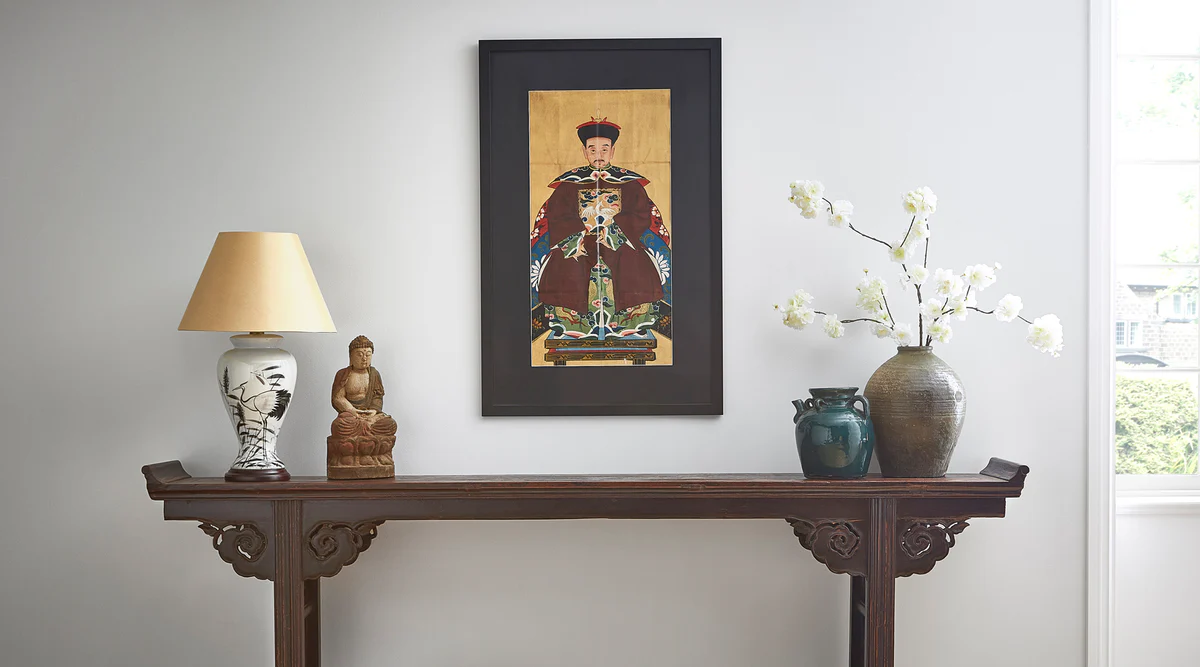
Square Routes: A Fascinating look at Chinese Official Rank Badges
Looking at the many squares of embroidered silk hanging in the Shimu showroom or on our website, few would realise the fascinating meaning and history behind them. Beginning in the 14th century during the Chinese Ming dynasty and Europe’s Middle Ages, the practice of wearing rank badges lasted until the fall of the Qing dynasty when in 1912 the last Emperor of China, Puyi was forced to abdicate.
The badges (buzi) are also known as Mandarin Squares and were used to denote the wearer’s Civil, Military or Imperial rank. Made from silk, they were normally sewn onto the front and back of the wearer’s clothing. The military and civil officials wore square badges which symbolized the earth and their earthly responsibilities, while the imperial family wore circular badges that symbolized heaven. With both civil and military officials wearing the same shape badge you may be wondering how one would tell them apart? Well, the Ming and Qing had a solution - civil officials wore badges embroidered with birds, whilst the military wore animals. Dragons were reserved for the sole use of the imperial family.
Though the rank badges were in use right through the Ming and Qing dynasties the designs changed over time, with several imperial regulations being issued to denote how they should be worn. In the early Ming dynasty, the birds on the civilian badges were always shown in pairs and in flight. This then changed into one bird in flight over another standing on a rock before finally evolving further during the Qing dynasty to feature just a single bird. Another difference between the Ming and Qing rank badges was that the Ming badges were larger and of a less defined square shape so as to look more appealing on the flowing Ming robes. The introduction of a form fitting surcoat designed for horse-riding brought about a further alteration to the badges, which were then made in two halves to allow the garment to be opened down the middle. Badges were also made in smaller sizes compared to previously and in a more regular square shape.
To become a civil official an individual was required to undergo years of intense study. In keeping with this the various birds used to represent different ranks were inspired by popular literary works. The ranks, in order of importance from lowest to highest during the Qing dynasty, were: the Paradise Flycatcher, Quail, Mandarin Duck, Egret, Silver Pheasant, Wild Goose, Peacock, Golden Pheasant and the Crane.
Military badges were composed of real and mystical animals that were renowned for their courage. By the later Qing dynasty the order of rank was: a sea horse (a horse running through the water) Rhinoceros, Panther, Bear, Tiger, Leopard, Lion and the mythical Qilin (part horse, part dragon, often depicted with antlers or horns). To become a military official the examination process was, unlike the civilian process, mainly physical and involved various elements such as horse riding and archery.

Not only was the colourful cast of animals and birds symbolic, but also the direction in which they faced. Civil officials would sit to the emperor’s left in court, so their emblems faced right as if to gaze upon the emperor. The wives of civilian officials also faced left to look at their husbands. Conversely, the military officials sat on the emperor’s right at court and so the animals on their badges faced to the left. However because the wives sat on their husbands’ left the female version of the military official badge faces right, so as to look at their husbands.
Today original insignia badges can fetch hundreds or even thousands of pounds at auction. Military badges are rarer and therefore more valuable, whilst the most common types tend to be the higher ranking civilian badges. Those mandarins who completed the long, taxing set of examinations to reach the highest rank – thought to be around half of all officials – could afford several sets of luxurious robes, each adorned with the Crane badge, and so these were the most common. Conversely, the lowest ranking officials were likely to afford just one set of robes and would probably be buried in those. Rarest of all are lower ranking military badges such as sea horses or rhinoceroses, with none of these thought to be available in any major public collection.
At Shimu we stock faithful reproductions of the old rank badges, along with other beautiful silk embroideries produced by hand in China, each mounted and framed for display. They make wonderful wall décor today, with centuries of history behind the intricate stitching and colourful designs.








Leave a comment